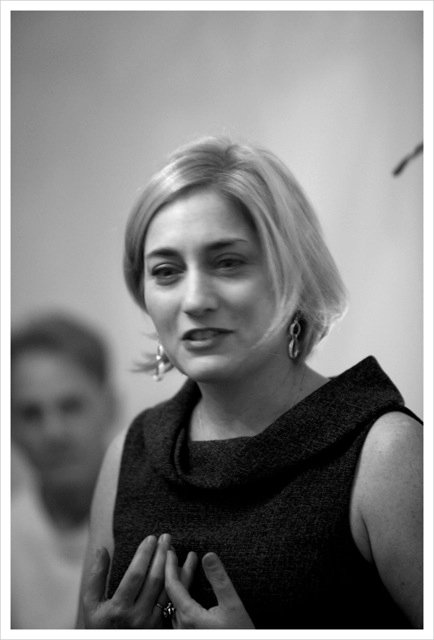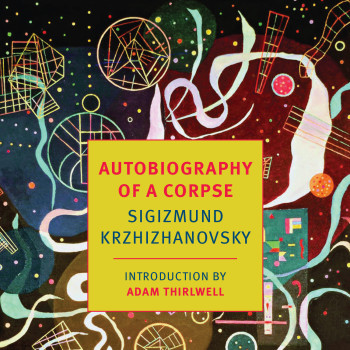In 2009, translator and literary critic Liesl Schillinger reviewed a collection of stories by a relatively-unknown Russian author who had lived in the 1920’s and, afraid that his work might run him afoul of the authorities, chose not to publish much of his own writing within his lifetime. Instead, he edited encyclopedias and shared his stories only by reading them aloud for friends. Decades later, they were finally released in Russian, and four years ago was the first time they appeared printed in English.
When Schillinger read Sigizmund Krzhizhanovsky‘s “Memories of the Future,” she was blown away. This month, the publishing imprint of The New York Review of Books, NYRB Classics, has released a second English-language collection of Krzhizhanovsky’s short stories, “Autobiography of a Corpse,” translated by Joanne Turnbull.
Ms. Schillinger joined us to share her connection to the author and read a passage from a story which appears in the new collection.

Hi, I’m Liesl Schillinger, I am a book critic and translator. A few years ago, I had the distinct pleasure of reviewing a new collection of stories by a writer I had never heard of before. It just stopped me in my tracks. This man was writing like Poe, like Kafka, like Gogol.

Sigizmund Krzhizhanovsky was writing in Moscow in the 1920s. Even though he was very active in the literary world, he censored himself because he was afraid he would get in trouble with the Soviet authorities and it wasn’t until 1989 that his stories came into the light of day in Russian, and only recently have they been published in English.
New York Review Books has been bringing them out and they just now released a new collection of stories, “Autobiography of a Corpse,” which is much more playful and less morbid than it may sound. These passages are from a story called “The Runaway Fingers.”
Two thousand ears turn toward the pianist Heinrich Dorn as he calmly adjusted the wicker seat of his swivel chair with long white fingers… The tails of his dress coat hung down from the chair while his fingers leapt onto the piano’s black case — and cantered down the straight road paved with ivory keys. Polished nails flashing, they first set off from a high octave C to the treble’s last, glassily tinkling keys.There waited a black block –the edge of the keyboard. The fingers wanted to go father; they stamped distinctly and fractionally on the last two keys–eyes here and there in the hall narrowed: “What a trill!” — then spun around on their tapered ends shod in fine epidermis and, leaping over one another, began galloping back. Halfway along the fingers slackened their pace, musingly choosing now black, now white keys for a footfall that was soft, but deeply impressed upon the strings.
Two thousand auricles leaned toward the stage.
A familiar nervous trembling seized the fingers; poised on the string-pressing hammers, they suddenly, in one violent bound, catapulted across twelve keys, coming to rest on C, E#, G, B.
Pause.
And again cutting loose from the chord, the fingers raced away in a rapid passage toward the end of the keyboard. The pianist’s right hand made to pull back, but its galloping fingers refused–on they flew at break-neck speed. The quarter octaves’ glassy tinkles flashed past. The treble’s auxiliary keys squeaked, the black keyboard rim rapped them on the nails. With a desperate tug, the fingers suddenly wrenched themselves free, hand and all, from the pianist’s cuff and jumped—diamond ring on the little finger glinting–down onto the floor. The parquet’s waxed wood struck their joints a painful blow, but the fingers, without missing a beat, picked themselves up and–mincing along on their pink shields of nails, vaulting high into the air with great arpeggio-like leaps–hared toward the hall’s exit.
The huge bulbous nose of someone’s boot nearly barred the way. Someone else’s dirty sole briefly pinned the little finger to the carpet. Hugging their pinched pinkie to them, the fingers darted under a floor length curtain. But a second later the curtain was hiked up to reveal two black columns that widened at the top: the Fingers understood–this was the dress hem of one of Dorn’s admirers. Swinging round on their ring finger, they jumped aside.
There wasn’t a minute to loose. All about them people were beginning to whisper. The whispers became murmurs, the murmurs a hubbub, the hubbub an outcry, and the outcry the roar and riot of a thousand feet.
“Catch them! Catch them!”
“What?”
“Where?”
Other members of the audience rushed up to the pianist. He was slumped on his chair in a deep faint, his left hand flopped on his knee; the empty cuff of his right still lay in the keyboard.
But the runaway fingers had no time for Dorn; working their long phalanges, bending and unbending their joints, they were sprinting prestissimo down a Turkish runner toward the brow of the stairs.
With wails and squeals, elbows elbowing elbows, people scrambled out of the way. From the hall came more cries of “Catch them! Where? What?” But the stairs had been left behind.
In one masterly bound, the fingers sailed over the threshold and out onto the street. The riot and racket broke off. The blank, benighted square, bathed in the yellow necklace of lamplights, gaped in silence.
“The Runaway Fingers,” by Sigizmund Krzhizhanovsky, 1922. Excerpted with permission from New York Review Books. The full story (yes, these fingers have a long journey ahead of them) can be found in the new collection “Autobiography of a Corpse.“



Pingback: Best Translated Book Award Link Roundup 2: The Longlist | Libromancy()